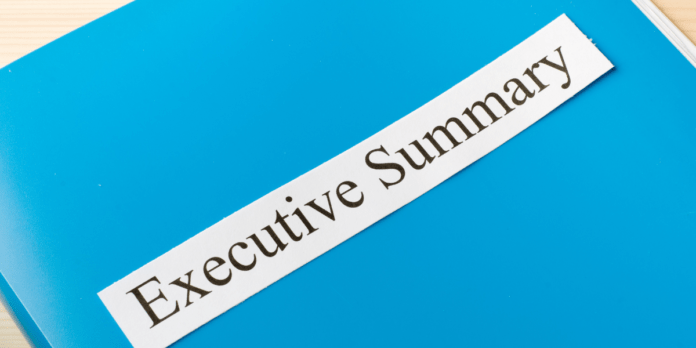The bad news is that executive summaries are critical documents and can be difficult to write. The executive summary serves multiple important purposes. Executive summaries can be used to outline every section of your investment proposition, business plan, or project proposal. They are also used to present your project or business to investors and other stakeholders. It must be compelling to get their attention.
Because it is at the top of the pile of documents, everyone will be paying attention to the executive summary. This puts pressure on you. It will explain everything that follows and make or break your project plan. It must be able to identify the needs of potential investors or clients and then zero in on them. We’ll help you write and format an executive summary that does exactly this.
What is an Executive Summary?
An executive summary is a brief section within a larger document such as a project proposal, investment proposition, or business plan. This summary is used to provide investors and stakeholders with a brief overview of key information regarding a business plan, such as the company description, market analyses, and financial information.
It includes a brief statement about the problem or proposal as well as background information, analysis, and a conclusion. Executive summaries are important because they help investors and executives decide whether or not to proceed with the proposal. Pitch decks can be used in conjunction with executive summaries to discuss the main selling points and benefits of a project or business plan.
An executive summary format, unlike an abstract, is a concise overview of the contents of the proposal. Abstracts are used more often in academic and research-oriented writing and serve as a teaser to the reader so they can decide if they wish to continue reading.
It can be difficult to organize everything for your executive summary.
How to write an executive summary
Depending on what document they are attached to, executive summaries can vary. An executive summary can be written for a business plan or project proposal, research paper, business case, and other documents.
There are some guidelines that you can follow when writing an executive summary.
Executive Summary Length
According to many books on executive summaries and training courses for professional speakers, the agreed-upon length for executive summary formats should be approximately five to ten percent of the entire report.
Use the appropriate language
It is important to use language that is appropriate for the intended audience. Before you can write professionally, it is important to understand the audience you are writing to. The language you use to write for a group consists of engineers. This is different from what you would use to communicate with financiers.
This includes not only the words but also the content and depth of explanation. It’s a summary. People will read it to quickly and easily find the key points.
Pithy Introduction
In the first paragraph, you want to grab a reader’s attention. A strong opening paragraph can draw a reader in, and encourage them to continue reading. But, it doesn’t have to be a joke. Jokes can be difficult. Keep your strengths in check, but keep in mind that most readers will only give you a few sentences before moving on.
It is important to describe who you are as an organization and why you have the experience, skills, and personnel to solve the problem in your proposal. You don’t need to write a long biography. Often, your name, address, and contact information are sufficient. However, you should highlight your strengths in relation to the business plan.
Relevant Information
It should not be different from the material following it. This summary is not meant to be a place for new ideas. This would confuse the reader and could jeopardize the whole of your proposal.
Establish the problem or need and convince your target audience to solve it. Once you have established the problem or need, it is important to propose the solution and demonstrate the value. Your recommendation should be clear and concise.
Justify your cause. Make sure you note the reasons your organization is the best fit for the solution that you propose. This is where you stand out from your competitors. testimonials from satisfied customers, methodology, or any other unique feature you provide. Don’t let this be about you. Keep the name of your potential client in mind.
Do not forget to conclude strong. This is where you can summarize and highlight the key points.
What to include in an Executive Summary
Your executive summary should reflect the content of the larger document it is part of. There are many examples of executive summaries on the internet, but we will focus our attention on project proposals and business plans.
How to write an executive summary for a business plan
Your executive summary should summarize the key points from each section of your business plan, as we have seen. A business plan describes the business’s business model, products, and services, as well as the objectives and marketing plan. Startups use them to present their ideas to investors.
These are the most frequently used sections of a business plan:
- Description of the company
- Products & Services
- SWOT Analysis
- Market Analysis
- Marketing Plan
- Financial Planning
- Funding Request
Executive summaries can also be used to describe the components of a project plan. Let’s find out what these elements are.
How to write an executive summary for a project proposal
A project proposal executive summary will summarize the most important information in your project management plan. This is the structure of our executive summaries template.
- Introduction: Why is your project important?
- Company Description: Let us know why we’re the best team for the job.
- Problem/Need: What’s the problem?
- Unique Solution: How do you define your value proposition? What are your main selling points?
- Proof: Research, evidence, and feasibility studies that show how your company can resolve the problem.
- Resources Outline all resources required for your project
- Return On Investment/Funding Request Please explain the profitability of your project as well as what the investors can expect.
- Market Analysis/Competition: Who is your target audience? Which are your competitors? What makes your company different from theirs?
- Marketing plan: Make a marketing strategy to describe your company’s sales, marketing, and partnership plans.
- Budget/Financial planning: What budget baseline do you need to plan your project?
- Timeline: What’s the estimated timeframe to finish the project?
- Team: Who and what are the members of the project team?
- Conclusions
You now know that executive summaries are different depending on what type of document you are working on. This is why you can use our executive summary template.
Executive Summary Template
Here’s how to combine all that information into an executive summary sample. This information can be found in our free executive summaries.
- Introduce, make sure you know your audience
- A bulleted table of contents is used in the table of contents
- Describe the role of the company and identify its strengths
- Describe the need or problem and the importance of it
- Provide a solution recommendation and its value
- Explain how the solution fits into your organization.
- A strong conclusion that again highlights the importance of this project
It can be used as an example executive summary and you can add or subtract elements to make it more suitable for your purposes. This sample executive summary contains the key elements you will need to create a project or business plan executive summary.
What to do after writing an executive summary
You should always begin with a draft, as with all writing. While your first draft should meet all of the above criteria, don’t let yourself get too bogged down in perfecting the prose. The first draft should be viewed as an exploratory mission. The goal is to gather all relevant information.
You should then go through the entire document and make sure nothing is missing or unclear. You should ensure that the document is clear and concise and speaks directly to the needs of your potential client.
Style and Grammar Proofread
The writing is just as important. You must ensure that your writing isn’t repetitive, cliche-like, or any other signs of poor writing. You don’t seek the Pulitzer Prize in Literature. However, you don’t want the reader to lose the reason why your organization can help them succeed.
Style is just as important as content. Your target audience will appreciate your natural style and informality. Formalism may be necessary if they are a conservative company. Modern companies are more casual in their corporate culture and formal writing might lead to them mistakingly identifying you as outdated and old.
Proofreading of the copy should be done at the end. This means that you should double-check the copy to ensure spelling accuracy and grammatical errors are corrected. The executive summary author is not the best person for editing it. Because they are familiar with the work, they can quickly overlook errors. Look for someone who is proficient in copy-editing. It is a sign of lack of professionalism and a reflection on your company that you are delivering sloppy content.
Critique of Executive Summaries
Every argument requires a rebuttal. While we support the use of executive summaries, it would be remiss to not mention some criticisms. Most people believe that an executive summary is too simplistic to accurately capture the complexity of large, complex projects.
True, many executives may only read the summary and miss the nuance of a proposal. This is a risk. If the executive summary is written in accordance with the above guidelines, it should provide a complete picture of the proposal. It should also encourage the reader to dig deeper into the documents for more details.
Executive summaries can be poorly written or very well. Executive summaries can be poorly written or not focused on the results or solution to the problem. They may also present information in a generalized way that is confusing or irrelevant to the reader. It’s possible to do many things wrong but the responsibility of following the rules falls on the reader.




